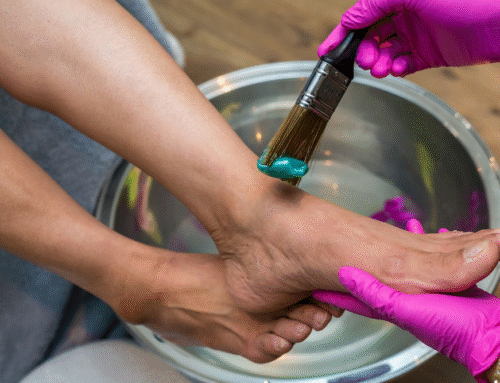Laser toenail fungus treatment in Glendale can vary. It is important to have all the right information on each treatment option for toenail fungus. Our nail doctors are specialists in toenail fungus. They will first consult you. They determine if what you have is a toenail fungus infection. Afterward, they explain each treatment option.
Types of Toenail Fungus
Toenail fungus, or onychomycosis, can develop in several different forms. This depends on the type of fungus involved and how the infection spreads through the nail. The first and most common type is distal subungual onychomycosis. It occurs when dermatophyte fungi invade the nail bed from the tip or sides of the nail. This form typically begins with a yellow or white spot near the edge of the nail. It then gradually spreads inward, causing the nail to thicken, discolor, and crumble at the edges. Because it affects the underside of the nail, it can be difficult to treat and often requires long-term therapy.
The second type, known as white superficial onychomycosis, is caused by fungi that attack only the surface of the nail plate. This results in white, chalky patches on the nail’s surface that can often be scraped away. It tends to progress more slowly. It is usually easier to treat since the infection does not penetrate deeply into the nail.
A third and less common form is proximal subungual onychomycosis, which begins at the base of the nail near the cuticle and spreads upward as the nail grows. This type is often associated with weakened immune systems. It is also associated with other underlying health conditions and may signal a more serious systemic issue.
A fourth and rare form, candida onychomycosis, is caused by yeast rather than dermatophyte fungi. It typically affects fingernails more than toenails. It causes swelling, redness, or even separation of the nail from the nail bed.
Finally, the fifth type is a total dystrophic onychomycosis is considered the end stage of long-standing infection. The nail becomes completely discolored, thickened, and deformed. Recognizing the specific type of toenail fungus is important because it helps determine the most effective treatment. Whether it is topical, oral, or laser-based, it improves the likelihood of achieving clear, healthy nails.

Common Symptoms
While invisible nail fungus may not exhibit visible signs, here are some of the typical symptoms associated with toenail fungus:
- Discoloration
- Brittleness of toenails
- Thickening of toenails
- Nail traumas/injuries
- Smelly toenails
If you’re experiencing any of these symptoms, it’s advisable to schedule a free consultation with our podiatrist in the Glendale office. They can determine whether you have a toenail fungus infection and recommend the best treatment option for you.
We offer free consultations
We offer free consultations to see if laser treatment is right for you. At our clinic, laser nail therapy with the PinPointe Footlaser is our specialty. We focus on this treatment because it offers a safe, effective, and medication-free solution for stubborn toenail fungus. We understand how frustrating it can be to deal with thick, discolored nails and how overwhelming it is to sort through different treatment options.
During this consultation, our foot doctors will evaluate your nails, discuss your health history, and determine whether laser treatment is the best choice. During your consultation, we will:
- Examine your nails to confirm the diagnosis and assess severity.
- Explain exactly how the PinPointe FootLaser works and what you can expect during and after treatment.
- Give you a realistic timeline for seeing clearer, healthier nails.
- Answer any questions you have about nail care and preventing reinfection.
Our goal is to help you confidently move forward with a treatment plan that finally addresses your toenail fungus safely and effectively, without the side effects or drug interactions of oral medications.
Treatment Options
A common treatment option is topical solutions. These have a cure rate of about five to ten percent. This is because the solution does not penetrate all the way through the nail bed. Therefore, it does not kill all the fungus.
Another treatment option is oral medications. These have a cure rate of about sixty percent. Although it is higher, it can lead to liver toxicity. Our nail doctors do not recommend this treatment option because it can lead to liver damage.

Laser Treatment for a Toenail Fungus in Glendale
Toenail fungus treatments in Glendale can vary. If you have caught nail fungus, it can be easily treated using the FDA-approved PinPointe laser, which typically only takes one treatment. Other treatments like topical solutions and oral medication are not as effective. Topical solutions have a very low cure rate. This is because the solution does not penetrate all the way through the nail bed. Oral medication has a higher cure rate than topicals, but our nail doctors do not recommend it. This is because it can lead to liver toxicity. You would need to have consistent blood tests throughout the course of taking the medication.
Our nail doctor in Glendale, CA recommends this treatment for toenail fungus. The PinPointe Laser treatment has the highest cure rate in the market. It has no side effects and no recovery period. As a result, you can go about your daily activities right after the treatment. Also, there’s no pain.
If you have any signs of nail fungus, call us at 800-672-0625 at our Glendale, CA location, or visit our website for more information on our doctors at one of our over 150 locations.




